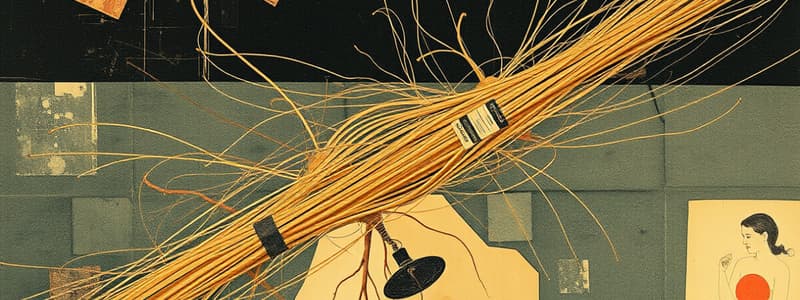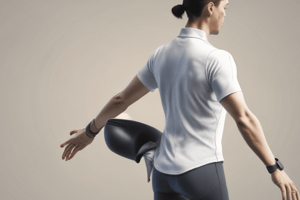Podcast
Questions and Answers
What role do Schwann cells play in the peripheral nervous system?
What role do Schwann cells play in the peripheral nervous system?
What is the primary function of the myelin sheath formed by oligodendrocytes in the CNS?
What is the primary function of the myelin sheath formed by oligodendrocytes in the CNS?
Which statement about the nodes of Ranvier is true?
Which statement about the nodes of Ranvier is true?
Which cranial nerve is solely composed of sensory afferent nerve fibers?
Which cranial nerve is solely composed of sensory afferent nerve fibers?
Signup and view all the answers
When does the formation of myelin sheaths typically begin?
When does the formation of myelin sheaths typically begin?
Signup and view all the answers
Which factor is most crucial for the maintenance of posture?
Which factor is most crucial for the maintenance of posture?
Signup and view all the answers
What role do antigravity muscles play in posture?
What role do antigravity muscles play in posture?
Signup and view all the answers
How does muscle tone contribute to posture?
How does muscle tone contribute to posture?
Signup and view all the answers
What is necessary for normal posture aside from the integrity of the reflex arc?
What is necessary for normal posture aside from the integrity of the reflex arc?
Signup and view all the answers
Which anatomical feature does the line of gravity pass through in the standing position?
Which anatomical feature does the line of gravity pass through in the standing position?
Signup and view all the answers
What are the characteristics of capsular cells in relation to Schwann cells?
What are the characteristics of capsular cells in relation to Schwann cells?
Signup and view all the answers
At what specific location is the initiation of nerve impulses most likely to occur?
At what specific location is the initiation of nerve impulses most likely to occur?
Signup and view all the answers
What is the resting potential of a neuron prior to any stimulus?
What is the resting potential of a neuron prior to any stimulus?
Signup and view all the answers
Which of the following accurately describes the process of depolarization?
Which of the following accurately describes the process of depolarization?
Signup and view all the answers
What is true about the action potential in small diameter axons?
What is true about the action potential in small diameter axons?
Signup and view all the answers
Which type of ganglia is found in the sympathetic trunks?
Which type of ganglia is found in the sympathetic trunks?
Signup and view all the answers
What distinguishes the shape of multipolar neurons?
What distinguishes the shape of multipolar neurons?
Signup and view all the answers
What encloses each autonomic ganglion?
What encloses each autonomic ganglion?
Signup and view all the answers
What is the primary role of the Merkel cell in relation to nerve impulses?
What is the primary role of the Merkel cell in relation to nerve impulses?
Signup and view all the answers
Which type of receptors are hair follicle receptors classified under?
Which type of receptors are hair follicle receptors classified under?
Signup and view all the answers
What happens to the receptor potential when a stimulus is applied to a receptor?
What happens to the receptor potential when a stimulus is applied to a receptor?
Signup and view all the answers
Which of the following statements about tactile domes is true?
Which of the following statements about tactile domes is true?
Signup and view all the answers
What event occurs when the hair follicle receptors are stimulated?
What event occurs when the hair follicle receptors are stimulated?
Signup and view all the answers
Which process describes the conversion of one form of energy to another in sensory perception?
Which process describes the conversion of one form of energy to another in sensory perception?
Signup and view all the answers
What is the role of the connective tissue sheath surrounding hair follicles in sensory detection?
What is the role of the connective tissue sheath surrounding hair follicles in sensory detection?
Signup and view all the answers
How does the amplitude of the receptor potential relate to the stimulus?
How does the amplitude of the receptor potential relate to the stimulus?
Signup and view all the answers
Which of the following accurately describes Pacinian Corpuscles?
Which of the following accurately describes Pacinian Corpuscles?
Signup and view all the answers
What is the primary feature of Ruffini Corpuscles?
What is the primary feature of Ruffini Corpuscles?
Signup and view all the answers
Which type of receptors is most associated with detecting pain?
Which type of receptors is most associated with detecting pain?
Signup and view all the answers
Where are free nerve endings NOT typically found?
Where are free nerve endings NOT typically found?
Signup and view all the answers
Which statement about the anatomical types of receptors is true?
Which statement about the anatomical types of receptors is true?
Signup and view all the answers
How do Free Nerve Endings differ from Pacinian Corpuscles?
How do Free Nerve Endings differ from Pacinian Corpuscles?
Signup and view all the answers
What type of sensations do Meissner's Corpuscles primarily detect?
What type of sensations do Meissner's Corpuscles primarily detect?
Signup and view all the answers
Which characteristic is true about the structural composition of Pacinian Corpuscles?
Which characteristic is true about the structural composition of Pacinian Corpuscles?
Signup and view all the answers
Study Notes
Posterior Root and Myelin Sheath
- Afferent fibers carry nerve impulses toward the Central Nervous System (CNS).
- Oligodendrocytes in the CNS form myelin sheaths for up to 60 axons.
- Schwann cells in the Peripheral Nervous System (PNS) myelinate individual nerve fibers.
- Cell bodies of sensory fibers are located in the posterior root ganglion.
- Myelin sheath formation begins before birth and continues in the first year after birth.
- Nodes of Ranvier cause segmentation and interruption in myelin sheaths.
Cranial Nerves
- Consist of 12 pairs, originating from the brain.
- Pass through foramina in the skull.
- Comprised solely of sensory afferent fibers, including olfactory and optic nerves.
Stimulation and Action Potentials
- Adequate stimulus applied to neuron surface initiates response in the initial segment of the axon.
- Membrane permeability changes, allowing Na ions to enter, resulting in depolarization.
- Resting potential is -80 mV; action potential can reach around +40 mV, but small diameter axons may be lower.
Autonomic Ganglia
- Include sympathetic and parasympathetic ganglia, located in sympathetic trunks and near viscera.
- Surrounded by connective tissue layers continuous with peripheral nerve epineurium and perineurium.
- Neurons are multipolar with irregularly shaped cell bodies.
Sensory Receptors
- Receptors can be classified as encapsulated or nonencapsulated.
- Nonencapsulated receptors include free nerve endings, detecting pain and pressure; found throughout the body.
Pacinian Corpuscles
- Located widely in the body, particularly in the dermis and subcutaneous tissue.
- Function as rapidly adapting mechanoreceptors sensitive to vibration, capable of responding to up to 600 stimuli per second.
Ruffini Corpuscles
- Found in the dermis of hairy skin; consist of large unmyelinated fibers and collagen bundles.
- Slowly adapting mechanoreceptors that respond to skin stretch.
Merkel Discs
- Present in hairless skin and hair follicles, functioning as slowly adapting touch receptors.
- Transmit pressure information, detecting touch intensity when applied against the skin.
Hair Follicle Receptors
- Nerve fibers wrap around hair follicles, responding to hair bending.
- Classified as rapidly adapting mechanoreceptors.
Function of Cutaneous Receptors
- Different areas of the body may only have limited receptor types yet remain sensitive to various stimuli.
- Sensation type is linked to specific CNS areas receiving afferent nerve signals.
Transduction of Sensory Stimuli
- Transduction involves converting different energy forms; for example, mechanical stimuli affect nerve membrane potential.
- Receptor potential is proportional to stimulus intensity, initiating additional nerve impulses.
Posture and Muscle Tone
- Normal posture involves constant adjustments of muscle tone based on nervous system inputs.
- Antigravity muscles stabilize the body by balancing gravitational forces around major joints.
- Posture integrity relies on both reflex arc functionality and neuronal impulse summation to anterior gray column cells.
Studying That Suits You
Use AI to generate personalized quizzes and flashcards to suit your learning preferences.
Related Documents
Description
Dive into the fascinating world of posterior root afferent fibers in the nervous system. This quiz explores the role of the myelin sheath, oligodendrocytes, and Schwann cells in transmitting nerve impulses towards the central nervous system. Test your knowledge on sensory fibers and the development of myelin before and after birth.




